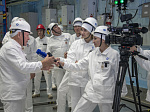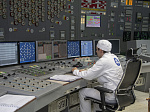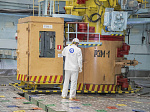23.11.2023
INFORMATION AND PUBLIC RELATIONS DEPARTMENT OF THE KURSK NPP
At the Kursk NPP the last fuel assembly was unloaded from the reactor of power unit No. 1
On November 21, 2023, the first stage of preparation for the decommissioning of power unit No. 1 of the Kursk NPP was completed: the last spent fuel assembly (FA) was unloaded from the reactor core ahead of schedule. After unloading nuclear fuel, the use of blocks as energy sources is impossible.
“The goal of our activity is to remove nuclear fuel from the unit. Then we will begin dismantling the equipment. This is a standard technological operation. The unloading and loading machine removed the cassette and transferred it to the cooling pool,” said Alexander Uvakin, director of the Kursk NPP.
Previously, power unit No. 1 of the Kursk NPP was shut down and switched to operating mode “without generating electricity.” During its operation, it generated over 251 billion kWh of electricity. Over the past 15 years that the power unit has been operating beyond its service life, it has generated almost 100 billion kWh (almost 40% of the output over 45 years). This confirms the correctness of the decision on deep modernization, extending the operating life on this basis and restoring the resource characteristics of the reactor. Revenue from the sale of electricity generated by the first power unit in 2021 alone exceeded 7.3 billion rubles.
“The unloading of spent fuel assemblies began in July 2022. The first batch consisted of 300 cassettes. Part of the fuel was sent for “afterburning” to the reactors of operating power units No. 3 and No. 4 of the Kursk NPP. Thanks to “afterburning,” the enterprise has the opportunity to increase the energy efficiency of the fuel - to manage the resource more efficiently,” explained Andrey Shchigolev, chief engineer of the Kursk NPP.
For reference:
The Kursk NPP (Kurchatov, Kursk region) is one of the largest generating sources of electricity in the Central Russian Black Earth Region. The consumers of its electricity are 19 regions of the Center of Russia. The station includes three power units with channel reactors with a total capacity of 3 million kW. Power unit No. 1, after 45 years of service, has been in operating mode without generation since December 2021. The station's power units were connected to the country's unified energy system in 1976, 1979, 1983 and 1985. In 1994-2009, all operating power units underwent deep technical modernization. Over the years of operation, the Kursk nuclear power plant has generated over 1 trillion kWh of electricity. At the moment, the construction of power units No. 1 and No. 2 of the Kursk NPP-2 replacement station with a new type of PWR-TOI reactor is underway. Their design service life is 60 years with the possibility of extension for another 20 years.
To replace the retired capacities, the construction of power units No. 1 and No. 2 of the Kursk NPP-2 generation “3+” is underway, built according to the PWR-TOI project (standard optimized informatized water-water power reactor). They have improved technical and economic indicators. The design service life of the main equipment has doubled to 60 years. The capacity of each power unit increased to 1255 MW, which is 25.5% more than the power units of the existing Kursk NPP.
In August 2021 and August 2023, respectively, specialists removed the last fuel assembly from the reactors of power units No. 1 and No. 2 with RBMK-1000 reactors at the Leningrad NPP (the units themselves were shut down after 45 years of safe operation in 2018 and 2020.) Thus, Russian nuclear scientists have moved from single unique projects to their serial implementation at all stages of production processes, including in terms of proven technologies for decommissioning power units.
Today, Russia continues to provide stable energy security. Energy is the basis for the progressive social and economic development of the country, the supply of industry and citizens. The domestic fuel and energy complex works to increase the competitiveness of the national economy, contributes to the development and improvement of the country's regions, cities, towns, to improve the quality of life of citizens. The share of low-carbon power generation in the Russian energy sector is already about 40%. In the future, taking into account the growth in the share of nuclear generation, it will only grow.
“The goal of our activity is to remove nuclear fuel from the unit. Then we will begin dismantling the equipment. This is a standard technological operation. The unloading and loading machine removed the cassette and transferred it to the cooling pool,” said Alexander Uvakin, director of the Kursk NPP.
Previously, power unit No. 1 of the Kursk NPP was shut down and switched to operating mode “without generating electricity.” During its operation, it generated over 251 billion kWh of electricity. Over the past 15 years that the power unit has been operating beyond its service life, it has generated almost 100 billion kWh (almost 40% of the output over 45 years). This confirms the correctness of the decision on deep modernization, extending the operating life on this basis and restoring the resource characteristics of the reactor. Revenue from the sale of electricity generated by the first power unit in 2021 alone exceeded 7.3 billion rubles.
“The unloading of spent fuel assemblies began in July 2022. The first batch consisted of 300 cassettes. Part of the fuel was sent for “afterburning” to the reactors of operating power units No. 3 and No. 4 of the Kursk NPP. Thanks to “afterburning,” the enterprise has the opportunity to increase the energy efficiency of the fuel - to manage the resource more efficiently,” explained Andrey Shchigolev, chief engineer of the Kursk NPP.
For reference:
The Kursk NPP (Kurchatov, Kursk region) is one of the largest generating sources of electricity in the Central Russian Black Earth Region. The consumers of its electricity are 19 regions of the Center of Russia. The station includes three power units with channel reactors with a total capacity of 3 million kW. Power unit No. 1, after 45 years of service, has been in operating mode without generation since December 2021. The station's power units were connected to the country's unified energy system in 1976, 1979, 1983 and 1985. In 1994-2009, all operating power units underwent deep technical modernization. Over the years of operation, the Kursk nuclear power plant has generated over 1 trillion kWh of electricity. At the moment, the construction of power units No. 1 and No. 2 of the Kursk NPP-2 replacement station with a new type of PWR-TOI reactor is underway. Their design service life is 60 years with the possibility of extension for another 20 years.
To replace the retired capacities, the construction of power units No. 1 and No. 2 of the Kursk NPP-2 generation “3+” is underway, built according to the PWR-TOI project (standard optimized informatized water-water power reactor). They have improved technical and economic indicators. The design service life of the main equipment has doubled to 60 years. The capacity of each power unit increased to 1255 MW, which is 25.5% more than the power units of the existing Kursk NPP.
In August 2021 and August 2023, respectively, specialists removed the last fuel assembly from the reactors of power units No. 1 and No. 2 with RBMK-1000 reactors at the Leningrad NPP (the units themselves were shut down after 45 years of safe operation in 2018 and 2020.) Thus, Russian nuclear scientists have moved from single unique projects to their serial implementation at all stages of production processes, including in terms of proven technologies for decommissioning power units.
Today, Russia continues to provide stable energy security. Energy is the basis for the progressive social and economic development of the country, the supply of industry and citizens. The domestic fuel and energy complex works to increase the competitiveness of the national economy, contributes to the development and improvement of the country's regions, cities, towns, to improve the quality of life of citizens. The share of low-carbon power generation in the Russian energy sector is already about 40%. In the future, taking into account the growth in the share of nuclear generation, it will only grow.




 career
career Innovations
Innovations Projects
Projects INTERNATIONAL BUSINESS
INTERNATIONAL BUSINESS